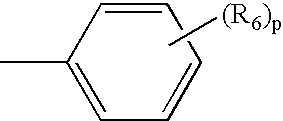Methods of treating conditions associated with an Edg-2 receptor
a technology of edg-2 receptor and treatment method, which is applied in the direction of biocide, heterocyclic compound active ingredients, amide active ingredients, etc., can solve the problems of poor physicochemical properties, limiting the potential use of phospholipid compounds as pharmaceutical agents, and failing to effectively discriminate phospholipid compounds
- Summary
- Abstract
- Description
- Claims
- Application Information
AI Technical Summary
Benefits of technology
Problems solved by technology
Method used
Image
Examples
example 1
6.1. Example 1
Intracellular Calcium Measurement Assays
[0209] LPA receptors such as Edg-2, couple to calcium effector pathways, and result in increases in intracellular calcium following receptor activation (An, 1998, J. Cell. Biochem. Supp., 30-31: 147-157). This biological response lends itself to a very efficient, high-throughput screen using a Fluorescence Imaging Plate Reader (FLIPR; Molecular Devices, Sunnyvale, Calif.). The FLIPR system is a real-time, cell-based assay system with continuous fluorescence detection using a cooled CCD camera. The FLIPR system was used to developing an Edg-2 receptor screen. Rat hepatoma cells stably expressing Edg-2 receptor were plated on 384-well plates and loaded with a calcium dye loading kit (Molecular Devices, Sunnyvale, Calif.) for 1 hour at room temperature. Cells were then placed on the FLIPR.sup.384 (Molecular Devices, Sunnyvale, Calif.) and excited by an argon laser at 488 nm. The data for the entire 384-well plate was updated every s...
example 2
6.2. Example 2
IL-8 and VEGF Assays
[0210] IL-8 and VEGF assays were performed by standard enzyme-linked immunosorbent assay ("ELISA") techniques. Cells were cultured in a 96 well format, serum starved overnight, and treated with LPA or S1P (doses range from 0.1-10 .mu.M in serum free medium) for 24 hours. Cell supernatants were then collected to measure the amount of IL-8 secreted.
[0211] The assay was a standard sandwich ELISA in which an anti-IL-8 or VEGF capture antibody was adsorbed to a plastic dish. Cell supernatants containing IL-8 or VEGF were added to the dish, and then an anti-IL-8 / VEGF biotinylated detection antibody and streptavidin-HRP were added.
[0212] Detection was via the addition of a substrate solution and colorimetric reading using a microtiter plate reader. The level of IL-8 or VEGF was interpolated by non-linear regression analysis from a standard curve.
[0213] All reagents were from R&D Systems, Minneapolis, Minn.: MAB208 and AF-293-NA (capture antibody for IL-8 a...
example 3
6.3. Example 3
Migration and Invasion Assays
[0214] Cells were plated in a 24 well format using Fluoroblok filter insert plates (8 .mu.M pore size) or Fluoroblok matrigel coated filter insert plates (Becton Dickinson, San Diego, Calif.). The assay was a modified Boyden Chamber assay in which a cell suspension (1.times.10.sup.5 cells / ml) was prepared in serum free medium and added to the top chamber. LPA or (doses ranged from 0.1-10 .mu.M in serum free medium) was added to the bottom chamber. Following a 20-24 hour incubation period, the number of cells migrating or invading into the lower chamber was quantitated by transferring the filter insert into a fresh 24-well plate containing 4 .mu.g / ml calcein AM (Molecular Probes, Sunnyvale, Calif.) in Hank's Balanced Salt Solution and staining for one hour.
[0215] Detection was via fluorescent readout at 450 nm excitation / 530 nm emission using a fluorimeter. The level of fluorescence correlated with cell number.
[0216] For most cells types, no...
PUM
| Property | Measurement | Unit |
|---|---|---|
| Mass | aaaaa | aaaaa |
| Molar density | aaaaa | aaaaa |
| Nanoscale particle size | aaaaa | aaaaa |
Abstract
Description
Claims
Application Information
 Login to View More
Login to View More - R&D
- Intellectual Property
- Life Sciences
- Materials
- Tech Scout
- Unparalleled Data Quality
- Higher Quality Content
- 60% Fewer Hallucinations
Browse by: Latest US Patents, China's latest patents, Technical Efficacy Thesaurus, Application Domain, Technology Topic, Popular Technical Reports.
© 2025 PatSnap. All rights reserved.Legal|Privacy policy|Modern Slavery Act Transparency Statement|Sitemap|About US| Contact US: help@patsnap.com



